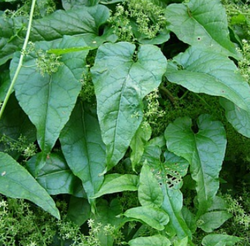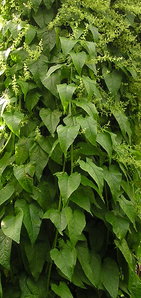 Hablitzia tamnoides, Caucasian spinach Hablitzia tamnoides, Caucasian spinach We can think of at least 180 great forest garden & perennial crops for cold climate Sweden. Want to hear about them? Over the course of the next year we will profile 5 a week on the blog. Perennial plants and crops offer a low energy, oil & resource input based foundation for future-proof agricultures. By default if an agriculture is to be called regenerative the bottom line is that it must be soil building, not soil depleting. Relentless deep tillage & poor soil husbandry (wifery?!) contributes to the majority of the 24 billion tons of topsoil lost every year on planet water. We are going to be focused on holistic polyculture grazing and perennial production at ridgedale over most of the site as this represents the most effective way to restore our degraded landscape, produce high value produce and ensure the future resource base we are managing holistically for in our decision making.  Genus Hablitzia Species tamnoides Common Name Caucasian spinach Form herbaceous Habit clumping Origin Europe Light part Moisture mesic Edible greens, shoots Hablitzia tamnoides, the sole species in the genus Hablitzia, is a herbaceous perennial plant, native to the Caucasus region. It is in the family Amaranthaceae, subfamily Betoideae, related to Beta, but unlike that genus, is a vine, climbing to 3 m or more tall in summer. Stephen Barstow, a local expert on perennial plants (whose book is coming out soon) wrote; Hablitzia tamnoides is a woodland climber from the Caucasus region that has in recent years become one of the most sought after vegetables amongst permaculturists and enthusiasts of forest gardening. However, until just a few years ago it was a rather obscure plant grown by a few botanical gardens in Europe and a handful of Scandinavian gardeners; that this plant should be one of the most productive and tasty vegetables would certainly have seemed unlikely. Why should this plant be “discovered” in Scandinavia? Well, the plant was originally introduced to gardens in Finland, Sweden and Norway as an attractive climber around 1870. It took only a few years for people to discover that the leaves were also edible. The plant never became very popular, but was grown in some of the biggest manor house gardens of the day. We have not so far been able to find any reference to the use of Hablitzia as a wild edible in its home territory in the Caucasus, although this may be because there have been few studies of wild food traditions in this region. Relic plants from the original plantings have survived to this day in particular in Finland and Sweden witnessing its hardiness. Thanks to the efforts mainly of Leena Linden at the University of Helsinki, seed has been collected from several of these surviving plants and deposited at the Nordic Genetic Resource Centre in Alnarp, Sweden (Nordgen). Hablitzia tamnoides is found particularly in spruce and beech woods in its native environment, among rocks and in ravines and along rivers. Hablitzia is named in honour of Carl Ludwig Hablizl, a naturalist from the 18th century who was also vice-governor in the Crimea. The epithet tamnoides refers to its resemblance to Black Bryony (Tamus communis), a native found in southern England and further south in Europe. Black Bryony is also a climber and its leaves are very similar in appearance to Hablitzia. In antiquity, the young shoots of Tamus were apparently preferred to asparagus and they are still used today in various spring dishes in several Mediterranean countries (they should, however, be cooked) My oldest plant is now 8-9 years old and produces over 100 good tasting shoots very early in spring and these can be cut at about 5-10cm (later just the tips of the shoots are used), this stimulating the plant to produce more shoots. I’ve harvested 2 or 3 times before I let the plant get on with its life. It has an incredible growth rate early in the year, climbing to 3m in just a few weeks. I have grown many perennial edibles here and I know no other edible which is anywhere near as productive so early in the season. Use the young shoots in all dishes for which one would have used spinach – in soups, pies, pizza, indian and oriental dishes etc., it’s also great in spring mixed salads. In Sweden the plant is called Rankspenat, whereas here in Norway it is Stjernemelde. In Finland, look for köynnöspinaatit and Kaukaasia Ronimalts i Estonia. Caucasian spinach was the English name adopted in an article I wrote for Permaculture Magazine a few years ago (see http://www.hagegal.info/innlegg/media-diverse-store-filer/media-stephen-h.php), but Scandinavian spinach and climbing spinach have also been used. I have also grown wild-sourced seed (from Georgia) and the plants are quite different from the Scandinavian type with smaller flowers, red, not green stems, they seem less hardy and seed seems more difficult to germinate. Perhaps this variety may turn out to be better adapted to milder climates? It certainly seems that the Scandinavian type has adapted over time to our climate. Search for this species in the most important reference works on edible plants (e.g. Ken Fern’s Plants for a Future and Stephen Facciola’s Cornucopia II: A Sourcebook of Edible Plants) and you won’t find it! Neither is it currently listed by the comprehensive Royal Horticultural Society’s Plant Finder (www.rhs.org.uk/rhsplantfinder/plantfinder.asp) nor is it in The European Garden Flora (with 17,000 taxa). Plants and seed are now offered by various seed saver organizations including the Norwegian Seed Savers (http://www.facebook.com/home.php?sk=group_131302060257210&ap=1) and I’ve listed seed at Seed Savers Exchange in the US for the last couple of years. It is also soon to be available as plants in European nurseries as I’ve supplied seed to several over the last couple of years. Although Hablitzia doesn’t have large showy flowers it is in my experience definitely a plant that gets noticed, so I also classify it as an edimental (edible ornamental). Botanically, Hablitzia belongs to the Goosefoot family (Chenopodiaceae) and is the only species in its genus (monotypic). It is therefore related to other well known vegetables such as beetroot, swiss chard, spinach, and garden orach (Atriplex hortensis), to the South American grain crop, quinoa (Chenopodiun quinoa), and the herb epazote or wormseed (Chenopodium ambrosioides) used in Mexican cuisine. Good King Henry (Chenopodium bonus-henricus) is also frequently cultivated as a spinach plant in herb gardens and wild collected in Mediterranean countries, but it is poor in comparison with Hablitzia in its usefulness (productivity) as a spinach plant and tastes too strong for my liking. Finally, there are a number of wild herbs and weeds which have long been used for food, such as fat hen (Chenopodium album) familiar to gardeners, sea beet and hastate orache (Atriplex hastata), both commonly found near the sea. I hope that members share their experiences and pictures here so that we can collectively get a better picture of how well Hablitzia grows in different climates. OUR FRIENDS AT PFAF HAVE AN AMAZING DATABASE OF SPECIES (UK BASED);However, Hablitzia tamnoides is missing!
21 Comments
Christer
2/3/2014 12:31:12 am
I want tö fill my garden with plants like these.
Reply
Robert
19/12/2015 10:16:10 am
Hi, I was wondering if you know of any UK suppliers of your Norwegian seedstock? I am intrigued at the idea that the species has adapted and changed in response to the local climate. Alternatively do you sell these? Many thanks.
Reply
Steve Medved
31/3/2016 09:26:15 am
Hi,
Reply
Judy Pierpont
11/8/2017 01:09:12 pm
Would you let me know if you have found answers to the questions in your post? I have the same ones. I successfully germinated and grew out 50 seedlings from my FEDCO seeds. A week ago I planted out 30 of them along the inside of my wire garden fence at a 2' spacing. Most are in partial shade, meaning shade some part of the day from plant matter on the other side of the fence. I'm in Ithaca, New York, probably the same zone as Putney, maybe a bit colder, but surely changing. Thanks.
Reply
Nicole
17/6/2019 01:05:27 pm
I am also looking for this info.
Lidia tindle
8/12/2016 04:16:12 am
Just come across this site in an email David Susuki Foundation, my spelling might be wrong on Susuki - thats in Canada. I'm in the UK north east cold winters. I'm really interested in a lot of the plants you are using and wonder if the seeds are available in England. Lidia
Reply
Jay Wilson
13/2/2017 12:22:47 am
Hi Lidia, not sure if you've managed to source this yet but Incredible Vegetables at Ashburton supply seeds - http://www.incrediblevegetables.co.uk/product-category/hablitzia-tamnoides/. I live in North East Scotland and am going to give it a go.
Reply
Peter
30/1/2017 09:20:49 am
I want to cultivate Hablitzia tamnoides in my garden in eastern Germany, but I have some questions:
Reply
rhonda meserole
9/8/2017 02:23:13 pm
Hi Peter,
Reply
Nicole
16/5/2019 10:14:13 pm
I am also in zone 3 and would really like to find out if anyone has had success growing these in similar conditions.
Peter
25/4/2020 06:39:39 am
I successfully grow Hablitzia tamnoides in my garden for 3 years. I bought seeds from the wild variety of Hablitzia tamnoides on eBay. The mother plants are growing in Poland (winters in Poland are colder than in Eastern Germany, so I can be sure that these plants will survive winters in Eastern Germany). The seller told me that he got his original seeds or plants from southern Caucasus, Georgia.
christina
28/5/2019 03:35:06 pm
i would love to try this but am in northern California, zone 8 - is there anyone who has tried it in a warmer area? please share any info you have - i plan to scatter the seed, sun & shade, winter & summer & see what happens....
Reply
Johann Kuntz
18/11/2020 03:33:55 pm
Hi Christina, I'm in Washington State in zone 8a. So far my <a href="https://johannsgarden.square.site/product/hablitzia-tamnoides-spinach-vine/57">Hablitzia</a> has been doing well here. Did you end up scattering seed? I grew out a large batch. They seemed to struggle at first in the starter tray, but once I got them into bigger pots with more fertile soil they really started doing well. I'm thinking with their ability to grow so fast they could be heavy feeders. If you want to try planting out one year old seedlings with lots of buds already forming for next year's crop let me know. I have a small nursery in Washington that is mostly local focused, but I can ship within the country.
Reply
Marie de viron
8/7/2019 09:15:44 am
J'ai fait germer quelques graines en pot l'année dernière. J'ai repiqué les plants dans mon potager et ils font jusqu'à 3 mètres. J'attends avec impatience le printemps prochain pour goûter les pousses. (Belgique)
Reply
Michelle
24/4/2020 06:45:15 pm
I've tried to germinate these three times and I keep failing. The first time I germinated them in cool conditions (below 70F, similar conditions to broccoli germination) and they died from damping off. The second time I tried them direct sown, in late winter. Some germinated but they were immediately eaten by animals. Third try I started in warm conditions (~80F) and they wilted and are now dying from damping off. I've used sterilized soil each time except for direct sowing. Does anyone have any suggestions? I'd really like to grow this plant. I live in USDA zone 5, Iowa, USA.
Reply
Peter
25/4/2020 05:29:11 am
Hablitzia tamnoides seeds need cool temperatures to germinate. I had success in germinating seeds using a fridge with +4 to +5 °C (+39 to +41 °F). I sowed the seeds on the surface of sand in a tray with holes in the bottom for good drainage (put a saucer underneath to catch excess water).
Reply
Marie de viron
25/4/2020 02:27:02 am
I live in Belguim. I saw some seeds in a pot and left then outside a winter. At spring time, I saw one or two leaves. I transplantated in the vegetables garden and it grew up fast. I got small white flowers. This spring, I cut delicious sprouts from the bush and left some that are growing. Hope the bush enlargers rapidely.
Reply
Leave a Reply. |
Details
Like us on FB Below for regular updatesStay up to date with customized updates you want to receive
Upcoming coursesArchives
December 2016
Categories
All
|

 RSS Feed
RSS Feed